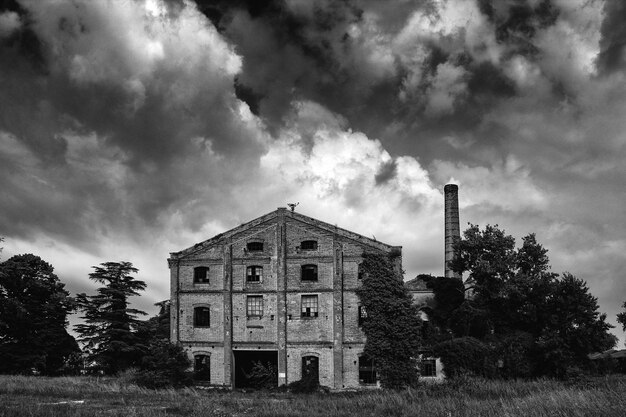Uncovering America’s Ghost Towns: Stories of Abandoned Settlements

Uncovering America’s Ghost Towns: Exploring Abandoned Settlements and Their Stories reveals the hidden histories and haunting beauty of forgotten communities across the United States, offering a glimpse into a bygone era.
Venture off the beaten path and into the heart of America’s past by uncovering America’s ghost towns: exploring abandoned settlements and their stories. These spectral remnants of once-thriving communities offer a unique glimpse into the lives, dreams, and eventual decline of those who called them home.
The Allure of Abandoned America
Ghost towns evoke a sense of mystery and intrigue, drawing visitors in with tales of fortunes sought, lives lived, and communities disbanded.
These deserted settlements serve as time capsules, preserving not only physical structures but also the echoes of human ambition and resilience.
Why Ghost Towns Captivate Us
The fascination with ghost towns stems from our innate curiosity about the past and our desire to connect with history in a tangible way.
- They offer a window into different eras, industries, and ways of life.
- They challenge our understanding of progress and the transient nature of communities.
- They spark our imaginations, allowing us to envision the lives of those who once inhabited these places.
Exploring these forgotten settlements can be a powerful and moving experience, prompting reflection on our own place in history and the legacy we leave behind.

They also act as mementos of what happens when economies become unsustainable for a community, reflecting economic booms and periods of crises.
Mining Towns and the Wild West
Many of America’s most iconic ghost towns are remnants of the Wild West era, born from the promise of gold, silver, and other valuable resources.
These boomtowns sprung up overnight, attracting prospectors, merchants, and adventurers from all corners of the globe.
Life in a Mining Boomtown
Life in these settlements was often harsh and unpredictable, characterized by a relentless pursuit of wealth and a constant struggle for survival.
- Lawlessness was rampant, with saloons, gambling dens, and brothels catering to the vices of the miners.
- Living conditions were primitive, with makeshift housing and limited access to basic amenities.
- The population fluctuated wildly, as people arrived and departed in search of the next big strike.
When the mines dried up, or the resources became depleted, these towns were quickly abandoned, leaving behind empty buildings and fading memories.
They reveal the tough reality of the old west, including the social and economic conditions that favored only a select few.
Vanishing Industries and Economic Shifts
Not all ghost towns were born from mining booms; many were casualties of changing industries, economic downturns, or natural disasters.
As industries declined, or populations shifted to urban centers, once-thriving communities found themselves struggling to survive.

The Impact of Economic Change
The decline of these towns often had devastating consequences for the residents, who lost their jobs, their homes, and their sense of community.
- The closure of factories, mills, and other businesses left many people unemployed and without prospects.
- The lack of infrastructure and services made it difficult to attract new residents or businesses.
- The aging population and the exodus of young people further accelerated the decline.
These ghost towns serve as stark reminders of the importance of economic diversification and the need to adapt to changing times.
The remains speak to the need for better infrastructure and support for communities left behind in the wake of larger economic shifts.
Preserving the Past
While some ghost towns have been completely lost to time, others have been preserved as historical sites or tourist attractions.
These preserved towns offer a valuable opportunity to learn about the past and to appreciate the rich history of the American West.
Efforts to Preserve Ghost Towns
Preservation efforts range from stabilizing existing buildings to creating museums and interpretive centers that tell the stories of the people who once lived in these towns.
- Preservationists work to protect these sites from vandalism, looting, and natural deterioration.
- Archaeologists conduct research to uncover artifacts and information about the past.
- Tour guides lead visitors through the towns, sharing stories and anecdotes about their history.
By preserving these ghost towns, we can ensure that future generations have the opportunity to learn from the past and to connect with the stories of those who came before us.
Preservation is crucial to maintain America’s history for future generations, letting them learn about our past, good and bad.
Exploring Ghost Towns Responsibly
When visiting ghost towns, it’s important to do so responsibly and with respect for the history and the environment.
Many of these sites are fragile and vulnerable to damage, and it’s crucial to follow guidelines and regulations to ensure their preservation.
Tips for Responsible Ghost Town Exploration
Before visiting a ghost town, research the local rules and regulations and obtain any necessary permits or permissions.
- Stay on designated trails and avoid entering unstable buildings or areas.
- Do not remove or disturb any artifacts or objects.
- Pack out all trash and leave the site as you found it.
By following these guidelines, we can ensure that these ghost towns continue to be accessible and enjoyable for generations to come.
Responsible exploration ensures our ghost towns stay safe and available to be seen for many years in the future.
Notable Ghost Towns to Visit
From the deserts of California to the mountains of Colorado, America is home to a diverse array of fascinating ghost towns.
Each of these settlements has its own unique story to tell, offering a glimpse into a different aspect of American history.
Examples of Must-See Ghost Towns
Some of the most popular and well-preserved ghost towns include:
- Bodie, California: A former gold mining boomtown that has been preserved in a state of “arrested decay.”
- St. Elmo, Colorado: A well-preserved mining town with many of its original buildings still standing.
- Thurmond, West Virginia: A once-thriving railroad town that declined after the decline of the coal industry.
These ghost towns offer a compelling glimpse into the past and a chance to connect with the stories of those who lived and worked there.
Each of the must-see towns carries their own uniquely tragic and wonderful history.
The Future of Ghost Towns
As interest in history and heritage tourism continues to grow, ghost towns are likely to become even more popular destinations.
With proper preservation and responsible tourism, these forgotten settlements can continue to offer valuable lessons about the past and insights into the human condition.
Ghost towns will continue to be visited and studied for many years in the future, assuming proper steps are taken to keep them alive.
- Increased awareness of the importance of preserving cultural heritage.
- Growing interest in exploring off-the-beaten-path destinations.
- Technological advancements that make it easier to document and share information about these sites.
By embracing these trends, we can ensure that America’s ghost towns remain an integral part of our national story for generations to come.
With continued interest in history, ghost towns will remain for years to come.
| Key Point | Brief Description |
|---|---|
| ⛏️ Mining Towns | Boomtowns emerged, driven by the promise of valuable resources, often abandoned when resources depleted. |
| 🏭 Economic Shifts | Towns declined due to vanishing industries, economic downturns, and shifts to urban centers. |
| 🏞️ Preservation Efforts | Preserving ghost towns helps future generations learn from the past; involves stabilization and museums. |
| 🗺️ Responsible Exploration | Visiting ghost towns should be done responsibly, respecting their history and fragile environment. |
FAQ
▼
A ghost town is typically defined as an abandoned settlement that once had a substantial population and economic activity. These towns are often deserted due to exhausted resources.
▼
Ghost towns offer a unique glimpse into the past, allowing visitors to experience history in a tangible way. Their eerie atmosphere and historical significance attract many history enthusiasts.
▼
Responsible exploration involves staying on marked trails, avoiding entering unstable buildings, not removing artifacts, and packing out all trash to preserve these sites for future visitors.
▼
Most ghost towns declined due to the exhaustion of natural resources (like minerals), economic shifts, natural disasters, or the relocation of industries and populations to urban centers.
▼
Yes, various preservation efforts aim to stabilize existing structures, create museums, and document the history. This protects these sites from vandalism and ensures future generations can learn from them.
Conclusion
Exploring America’s ghost towns offers a captivating journey into the past, revealing the stories of ambition, resilience, and change of the people who once called them home. These abandoned settlements provide a unique perspective on American history and a valuable opportunity to reflect on the enduring impact of the past on the present.






